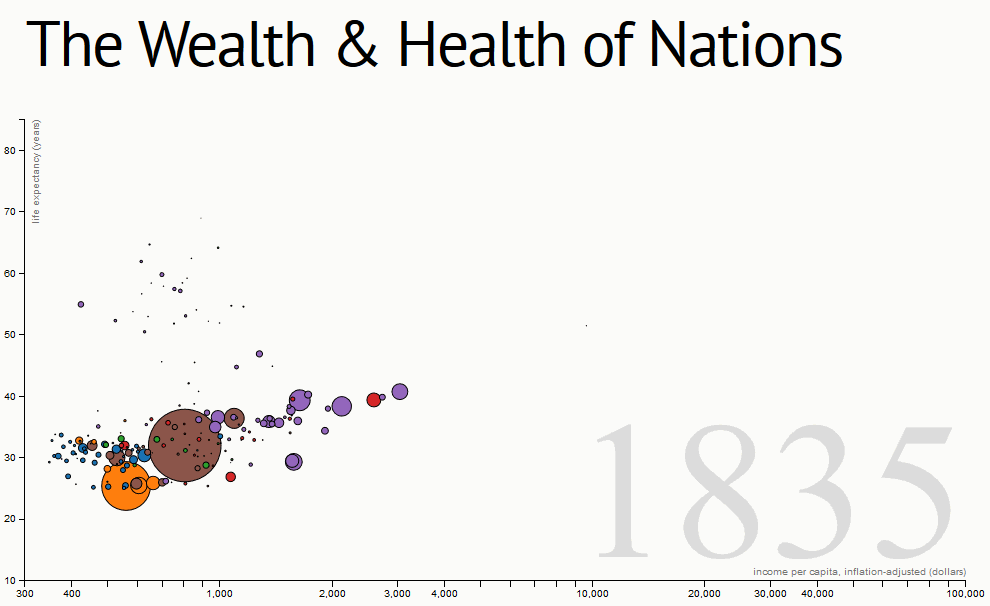I am working on a d3 sample http://bost.ocks.org/mike/nations/:

I am trying to add tooltip of the json data on the corresponding circles as and when i move the cursor over the years. However it is showing only the first year's value. It is not displaying the data corresponding to the year selected.
<!DOCTYPE html>
<meta charset="utf-8">
<title>Mock up Bubble chart DV</title>
<style>
@import url(../style.css?20120427);
#chart {
margin-left: -40px;
height: 506px;
}
text {
font: 10px sans-serif;
}
.dot {
stroke: #000;
}
.axis path, .axis line {
fill: none;
stroke: #000;
shape-rendering: crispEdges;
}
.label {
fill: #777;
}
.year.label {
font: 500 96px "Helvetica Neue";
fill: #ddd;
}
.year.label.active {
fill: #aaa;
}
.overlay {
fill: none;
pointer-events: all;
cursor: ew-resize;
}
</style>
<header>
</header>
<h1>Mock up of Bubble chart DV</h1>
<p id="chart"></p>
<input type="submit" value="Start" onclick=start();>
<input type="submit" value="Stop" onclick=stop();>
<script src="http://d3js.org/d3.v2.js?2.8.1"></script>
<script>
// Various accessors that specify the four dimensions of data to visualize.
function x(d) { return d.checkins; }
function y(d) { return d.Checkintimes; }
function radius(d) { return d.teamsize; }
function color(d) { return d.region; }
function key(d) { return d.name; }
var b = false;
var svg = d3.select("#chart");
var thisyear=2000;
var parsedData;
var chksvg = d3.select("svg");
function start()
{
if(chksvg.empty())
{
//alert("not intialised");
document.getElementById('chart').innerHTML="";
// Chart dimensions.
var margin = {top: 29.5, right: 29.5, bottom: 29.5, left: 59.5},
width = 960 - margin.right,
height = 500 - margin.top - margin.bottom;
// Various scales. These domains make assumptions of data, naturally.
//var xScale = d3.scale.log().domain([300, 1e5]).range([0, width]),
var xScale = d3.scale.log().domain([10, 3000]).range([0, width]),
yScale = d3.scale.linear().domain([10, 85]).range([height, 0]),
radiusScale = d3.scale.sqrt().domain([0, 40]).range([5, 40]),
colorScale = d3.scale.category10();
// The x & y axes.
var xAxis = d3.svg.axis().orient("bottom").scale(xScale).ticks(12, d3.format(",d")),
yAxis = d3.svg.axis().scale(yScale).orient("left");
// Create the SVG container and set the origin.
var svg = d3.select("#chart").append("svg")
.attr("width", width + margin.left + margin.right)
.attr("height", height + margin.top + margin.bottom)
.append("g")
.attr("transform", "translate(" + margin.left + "," + margin.top + ")");
// Add the x-axis.
svg.append("g")
.attr("class", "x axis")
.attr("transform", "translate(0," + height + ")")
.call(xAxis);
// Add the y-axis.
svg.append("g")
.attr("class", "y axis")
.call(yAxis);
// Add an x-axis label.
svg.append("text")
.attr("class", "x label")
.attr("text-anchor", "end")
.attr("x", width)
.attr("y", height - 6)
.text("Avg checkins/dev");
// Add a y-axis label.
svg.append("text")
.attr("class", "y label")
.attr("text-anchor", "end")
.attr("y", 6)
.attr("dy", ".75em")
.attr("transform", "rotate(-90)")
.text("Mean Time between successful builds(hrs)");
// Add the year label; the value is set on transition.
var label = svg.append("text")
.attr("class", "year label")
.attr("text-anchor", "end")
.attr("y", height - 24)
.attr("x", width)
.text(2000);
}
else
{
//enableInteraction();
}
//alert("Start Clicked");
// Load the data.
d3.json("bubble_chart_new.json", function(nations) {
// A bisector since many nation's data is sparsely-defined.
var bisect = d3.bisector(function(d) { return d[0]; });
//console.log(bisect);
// Add a dot per nation. Initialize the data at 2000, and set the colors.
var dot = svg.append("g")
.attr("class", "dots")
.selectAll(".dot")
.data(interpolateData(2000))
.enter().append("circle")
.attr("class", "dot")
.style("fill", function(d) { return colorScale(color(d)); })
.call(position)
.sort(order);
// Add a title.
//dot.append("title").text(function(d) { return d.name});
// Add an overlay for the year label.
var box = label.node().getBBox();
var overlay = svg.append("rect")
.attr("class", "overlay")
.attr("x", box.x)
.attr("y", box.y)
.attr("width", box.width)
.attr("height", box.height)
.on("mouseover", enableInteraction);
// Start a transition that interpolates the data based on year.
svg.transition()
.duration(30000)
.ease("linear")
.tween("year", tweenYear)
.each("end", enableInteraction);
// Positions the dots based on data.
function position(dot) {
dot.attr("cx", function(d) { return xScale(x(d)); })
.attr("cy", function(d) { return yScale(y(d)); })
.attr("r", function(d) { return radiusScale(radius(d)); });
}
// Defines a sort order so that the smallest dots are drawn on top.
function order(a, b) {
return radius(b) - radius(a);
}
// After the transition finishes, you can mouseover to change the year.
function enableInteraction() {
var yearScale = d3.scale.linear()
.domain([2000, 2009])
.range([880,895])
.clamp(true);
// Cancel the current transition, if any.
svg.transition().duration(0);
overlay
.on("mouseover", mouseover)
.on("mouseout", mouseout)
.on("mousemove", mousemove)
.on("touchmove", mousemove);
function mouseover() {
label.classed("active", true);
}
function mouseout() {
label.classed("active", false);
}
function mousemove() {
//console.log(yearScale.invert(d3.mouse(this)[0]));
displayYear(yearScale.invert(d3.mouse(this)[0]));
dot.append("title").text(function(d,i) { return d.name + ": " + d.checkins + ":" + d.teamsize});
}
}
// Tweens the entire chart by first tweening the year, and then the data.
// For the interpolated data, the dots and label are redrawn.
function tweenYear() {
var year = d3.interpolateNumber(thisyear, 2009);
//console.log(year);
//var year = d3.interpolateRound(thisyear, 2009);
return function(t) { displayYear(year(t)); };
}
// Updates the display to show the specified year.
function displayYear(year) {
thisyear=year;
dot.data(interpolateData(year), key)
.call(position)
.sort(order);
label.text(Math.round(year));
)
}
// Interpolates the dataset for the given (fractional) year.
function interpolateData(year) {
var yeartest= year;
return nations.map(function(d,i) {
return {
name: d.name,
region: d.region,
checkins: interpolateValues(d.checkins, year),
teamsize: interpolateValues(d.teamsize, year),
Checkintimes: interpolateValues(d.Checkintimes, year)
};
//console.log(d.name + d.teamsize + d.checkins);
});
}
// Finds (and possibly interpolates) the value for the specified year.
function interpolateValues(values, year) {
var i = bisect.left(values, year, 0, values.length - 1),
a = values[i];
if (i > 0) {
var b = values[i - 1],
t = (year - a[0]) / (b[0] - a[0]);
/*console.log("year = " + year);
console.log("a[0] = " + a[0]);
console.log("b[0] = " + b[0]);
console.log("t value = " + t);
console.log("a[1] value = " + a[1]);
console.log("return value = " + a[1] * (1 - t) + b[1] * t);*/
//return a[1] * (1 - t) + b[1] * t;
return a[1]* (1 - t) + b[1] * t ;
}
return a[1];
}
});
}
function stop()
{
d3.selectAll("*").transition().delay(0);
//alert("stop Clicked");
}
</script>
json file contains the following:
[
{
"name":"Search&Navigator",
"region":"IPScience",
"checkins":[[2000,100],[2001,200],[2002,300],[2003,275],[2004,222],[2005,280],[2006,281],[2007,400],[2008,55],[2009,300]],
"teamsize":[[2000,10],[2001,7],[2002,7],[2003,12],[2004,5],[2005,3],[2006,10],[2007,12],[2008,12],[2009,10]],
"Checkintimes":[[2000,40],[2001,50],[2002,60],[2003,50],[2004,40],[2005,30],[2006,30],[2007,35],[2008,30],[2009,30]]
}
]
